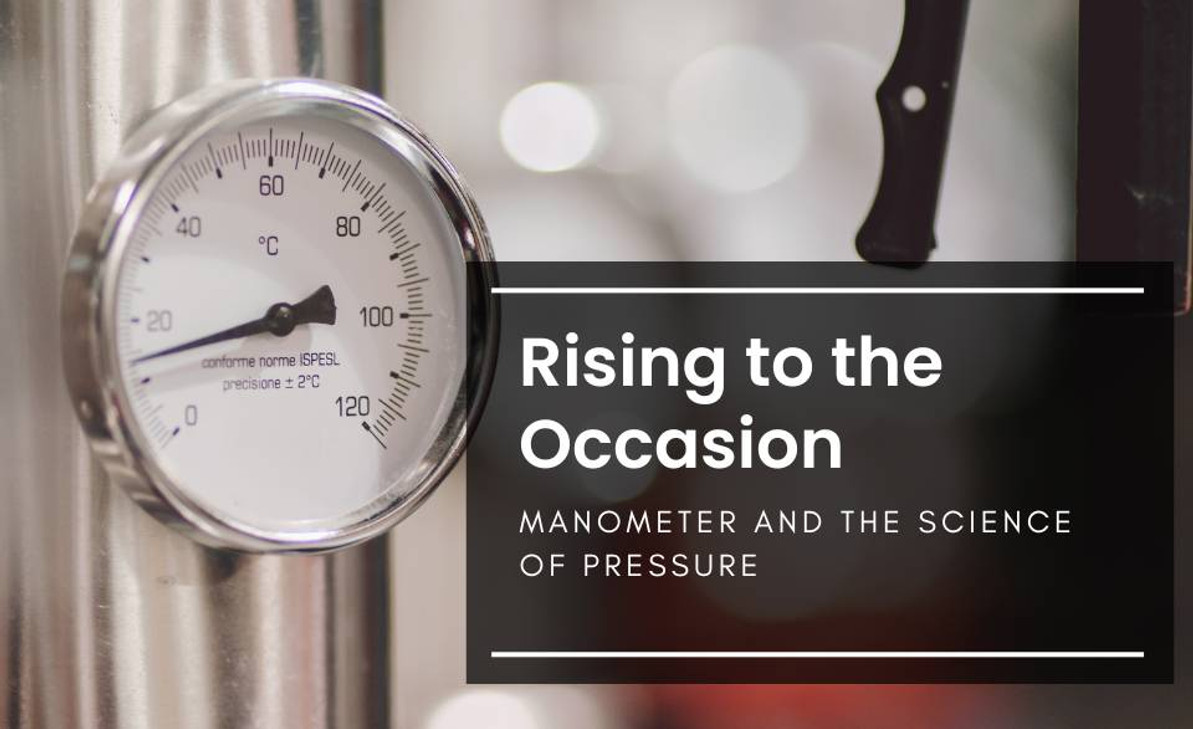Rising to the Occasion: Manometer and the Science of Pressure
In the world of measurement and precision, a device has quietly but indispensably played a role in countless industries, from engineering to meteorology, from aviation to chemical processing. It's a device that, despite its seemingly simple design, holds the power to reveal the invisible forces that shape our physical world – pressure. Ladies and gentlemen, let me introduce you to the unassuming yet remarkable world of manometers.
Manometers are the unsung heroes of pressure measurement, offering us a glimpse into the mysteries of gases and liquids, and in doing so, they've revolutionized how we build, create, and understand our surroundings. From the cavernous depths of the Earth to the vast reaches of our atmosphere, from the intricate workings of an automobile engine to the secrets of the cosmos, manometers have silently recorded the forces that make our universe tick.
In this exploration, we'll dive into the world of manometers, unraveling their history, dissecting their internal workings, and discovering the many facets of their applications. We'll unveil the secrets of their precision, uncover the nuances of their operation, and ponder the intricacies of their pros and cons. So, as we embark on this journey into the world of pressure measurement, prepare to be captivated by the humble yet extraordinary manometer and the profound impact it has had on our understanding of the physical forces that govern our world.
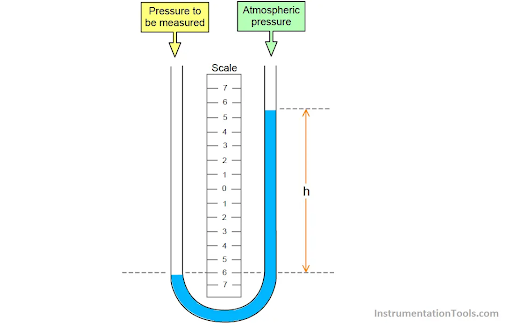
Fig 1. U-tube pressure manometer
What is a Manometer?
A manometer is a device used for measuring the pressure of gases and liquids. It consists of a tube or column partially filled with a liquid (often mercury or a colored oil) and open to the substance whose pressure is being measured. The liquid in the manometer responds to changes in pressure by rising or falling within the tube, and this change in liquid level is used to determine the pressure of the substance being measured.
There are several types of manometers, including the following common ones:
- U-Tube Manometer: This is a simple manometer consisting of a U-shaped tube partially filled with a liquid. One end of the tube is exposed to the substance whose pressure is being measured, while the other end is typically open to the atmosphere. The difference in liquid levels between the two arms of the U-tube provides a direct measure of the pressure difference between the substance and the atmosphere.
- Inclined Manometer: In this type of manometer, the U-shaped tube is inclined at an angle instead of being vertical. It is often used to measure small pressure differences with higher precision.
- Piezometer Tube: A piezometer is a type of manometer that is used to measure the pressure at a specific point within a fluid, such as in a pipeline or a reservoir. It typically consists of a vertical tube with one end connected to the fluid and the other end open to the atmosphere.
- Bourdon Tube: While not a manometer in the traditional sense, Bourdon tubes are often used as pressure indicators in various devices and systems. They consist of a curved tube that straightens as pressure increases, and this straightening is often connected to a pointer or dial to provide a pressure reading.
Manometers are commonly used in various industries, including engineering, physics, chemistry, and HVAC (heating, ventilation, and air conditioning), to measure and monitor pressure in different applications. They are relatively simple and reliable instruments for pressure measurement and are available in various designs to suit specific needs.
When was the first manometer made?
The concept of the manometer, as a device for measuring fluid pressure, has been around for centuries, but it's challenging to pinpoint an exact date for its invention. Manometers, in various forms, have evolved.
One of the earliest recorded uses of a simple manometer-like device dates back to the work of Evangelista Torricelli, an Italian physicist, in the 17th century. In 1643, Torricelli invented the mercury barometer, which is a type of manometer, to measure atmospheric pressure. This invention was a significant step in the development of pressure measurement devices.
The U-tube manometer, which is a type of manometer commonly used for measuring pressure differences in fluids, also has a long history and has likely been used in different forms by scientists and engineers for centuries.
It's important to note that the precise timeline and development of these instruments can be challenging to trace accurately, as many early inventors and scientists made contributions to the field of pressure measurement. So, while the manometer as we know it today may not have been invented at a specific date, its roots can be traced back to the early modern period with the work of scientists like Torricelli.
Manometer internal parts
A manometer is a relatively simple device with a few key internal parts, which may vary slightly depending on the specific type and design of the manometer. Here are the basic internal parts of a common U-tube manometer, which is widely used for measuring pressure differences in fluids:
- U-shaped tube: The U-tube is the central component of the manometer. It's usually made of glass or clear plastic and is filled with a liquid (often mercury or oil) to a certain level. The tube is shaped like the letter "U" or a vertical column with two arms. One arm is open to the substance or system whose pressure is being measured, while the other arm is typically open to the atmosphere.
- Liquid: The liquid inside the U-tube serves as the indicator of pressure. Common liquids used include mercury, water, or a colored oil. The choice of liquid depends on the specific application and the range of pressures being measured.
- Scale: A scale is often attached alongside one or both arms of the U-tube. It provides a reference point for measuring the difference in liquid levels in the two arms. This difference in liquid level corresponds to the pressure difference being measured.
- Reference Point: The reference point is usually the level of the liquid in the arm that is open to the atmosphere. It's the starting point from which pressure differences are measured. When there is no pressure difference, the liquid in both arms of the U-tube will be at the same level as the reference point.
- Connecting Tubes: In some manometers, there may be connecting tubes that lead from the substance or system being measured to the U-tube. These tubes ensure that the pressure in the system is transmitted accurately to the liquid in the U-tube.
The operation of a manometer is relatively straightforward: when the pressure in the system being measured differs from atmospheric pressure, it causes the liquid in one arm of the U-tube to rise and the other arm to fall, creating a measurable difference in liquid levels. This difference is then read on the scale to determine the pressure difference.
Different types of manometers, such as inclined manometers or digital manometers, may have variations in their internal components or additional features, but the fundamental principle of measuring pressure using a liquid column remains consistent.
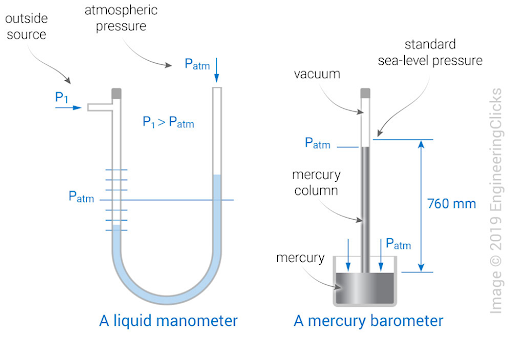
Fig 2. A liquid manometer
Manometer working principle
The working principle of a manometer is based on the fundamental concept of hydrostatic pressure, which states that the pressure at a given point in a fluid at rest is the same in all directions and increases with depth. In the context of a manometer, it measures the pressure difference between two points within a fluid, often a gas or a liquid.
Here's how a basic U-tube manometer works:
- Setup: A U-tube manometer consists of a U-shaped tube, typically made of glass or clear plastic, partially filled with a liquid (e.g., mercury, water, or oil). One end of the U-tube is open to the substance or system whose pressure you want to measure, while the other end is open to the atmosphere (or another reference point).
- Initial State: In its initial state, when there is no pressure difference between the two ends of the U-tube, the liquid levels in both arms are at the same height. This level corresponds to the reference point, which is often considered as zero pressure.
- Pressure Difference: When there is a pressure difference between the two points being measured, it causes the liquid in the U-tube to move. If the pressure in the system being measured is greater than atmospheric pressure, the liquid in the arm connected to the system will rise, while the liquid in the other arm connected to the atmosphere will fall. The difference in the liquid levels in the two arms is directly proportional to the pressure difference between the system and the atmosphere.
- Reading the Pressure: To determine the pressure difference, you read the difference in height (h) between the two liquid levels on the scale attached to the U-tube. The pressure difference (P) is calculated using the hydrostatic pressure formula:P = ρ * g * hWhere:
- P is the pressure difference.
- ρ (rho) is the density of the liquid in the U-tube.
- g is the acceleration due to gravity.
- h is the height difference between the two liquid levels.
By measuring the height difference and knowing the density of the liquid and the value of gravitational acceleration, you can calculate the pressure difference between the two points being measured.
In summary, a manometer measures pressure by comparing the height of a liquid column in one arm connected to the system under investigation to the height of a reference column in the other arm connected to a reference point (often atmospheric pressure). The difference in liquid levels indicates the pressure difference, and this difference can be used to determine the pressure of the system relative to the reference point.
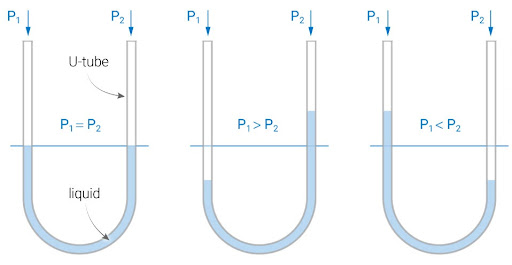
Fig 3. A manometer working principle
Manometer Types
Manometers come in various types and designs, each suited for specific applications and measurement requirements. Here are some common types of manometers:
- U-Tube Manometer: This is one of the simplest and most common types of manometer. It consists of a U-shaped tube partially filled with a liquid (e.g., mercury, water, or oil). One end of the U-tube is exposed to the pressure being measured, while the other end is open to the atmosphere. The difference in liquid levels in the two arms provides a direct measure of the pressure difference.
- Inclined Manometer: An inclined manometer is similar to a U-tube manometer but with the U-shaped tube inclined at an angle rather than being vertical. This design allows for more precise measurement of small pressure differences.
- Piezometer Tube: A piezometer is used to measure the pressure at a specific point within a fluid, such as in a pipeline or a reservoir. It typically consists of a vertical tube with one end connected to the fluid and the other end open to the atmosphere. It measures the pressure at a single point.
- Bourdon Tube: While not a manometer in the traditional sense, Bourdon tubes are often used as pressure indicators in various devices and systems. They consist of a curved, flattened tube that straightens as pressure increases. This straightening is often connected to a pointer or dial to provide a pressure reading.
- Digital Manometer: Digital manometers use electronic sensors and a digital display to provide pressure readings. They are often more precise and easier to read than traditional fluid-filled manometers. They are commonly used in industrial settings.
- Differential Manometer: A differential manometer measures the difference in pressure between two points. It typically consists of two U-tube manometers connected to a common reference point. This type is useful for measuring pressure drops across filters, pumps, or other components in fluid systems.
- McLeod Gauge: This specialized manometer is used to measure very low pressures, often in vacuum applications. It operates on the principle of compressing a gas sample and measuring the pressure increase.
- Manometric Capsule: A manometric capsule manometer consists of two flexible capsules connected. One capsule is exposed to the pressure being measured, while the other is exposed to a reference pressure. The deflection of the capsules provides a measure of the pressure difference.
- Ultrasonic Manometer: Ultrasonic manometers use sound waves to measure pressure. They are non-intrusive and can be used in applications where contact with the fluid is not desired.
- Pitot Tube Manometer: This type of manometer is used to measure fluid velocity by determining the difference between static pressure and dynamic pressure. It's commonly used in aerodynamics and fluid mechanics.
The choice of manometer type depends on factors such as the range of pressures to be measured, the level of precision required, the nature of the fluid, and the specific application. Different types of manometers offer varying levels of accuracy, ease of use, and suitability for different measurement tasks.
- Description: U-tube manometers consist of a U-shaped tube partially filled with a liquid. One end is open to the substance being measured, and the other is open to the atmosphere.
- Working Principle: It relies on the principle of hydrostatic pressure. The difference in liquid levels in the two arms indicates the pressure difference.
- Applications: Commonly used for measuring pressure differences in gases or liquids, such as in HVAC systems, laboratories, and industrial processes.
- Pressure Range: Suitable for a wide range of pressures, depending on the choice of liquid.
- Industries: HVAC, chemical engineering, fluid dynamics.
- Pros: Simple design, relatively inexpensive, suitable for a broad pressure range.
- Cons: Limited precision, can be affected by temperature variations, and not ideal for high-pressure measurements.
U-Tube Manometer:
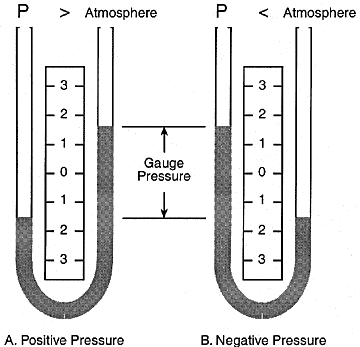
Fig 4. U-tube manometer
- Description: Similar to a U-tube manometer but with the U-tube inclined at an angle.
- Working Principle: Works on the same principle as a U-tube manometer but offers higher precision for small pressure differences.
- Applications: Used when more accurate measurements of small pressure differences are required, often in laboratories and research settings.
- Pressure Range: Moderate pressure range.
- Industries: Research, fluid mechanics, aerospace.
- Pros: Improved precision for small pressure differences.
- Cons: Limited to moderate pressure ranges, maybe more complex to read.
Inclined Manometer:
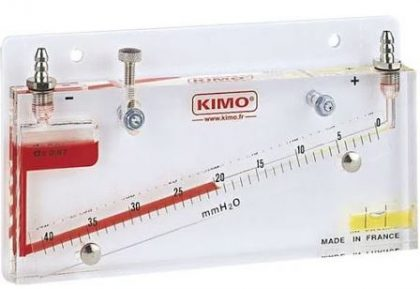
Fig 5. Example of an inclined manometer
- Description: A vertical tube with one end open to the fluid being measured and the other open to the atmosphere.
- Working Principle: Measures the pressure at a specific point within a fluid.
- Applications: Used in geotechnical engineering to measure water pressure in soil or in hydrology to measure groundwater levels.
- Pressure Range: Typically low to moderate pressures.
- Industries: Civil engineering, environmental monitoring.
- Pros: Simple and direct measurement of point pressure.
- Cons: Limited to specific point measurements, not suitable for dynamic measurements.
- Description: A curved tube that straightens as pressure increases.
- Working Principle: Measures pressure by the deformation of the curved tube.
- Applications: Widely used in pressure gauges for various applications, including industrial processes and automotive systems.
- Pressure Range: Available for a wide range of pressures.
- Industries: Automotive, manufacturing, oil and gas.
- Pros: Suitable for a broad pressure range, robust, and can provide continuous readings.
- Cons: Less accurate than laboratory-grade instruments, not ideal for very low pressures.
Piezometer Tube:
Bourdon Tube:
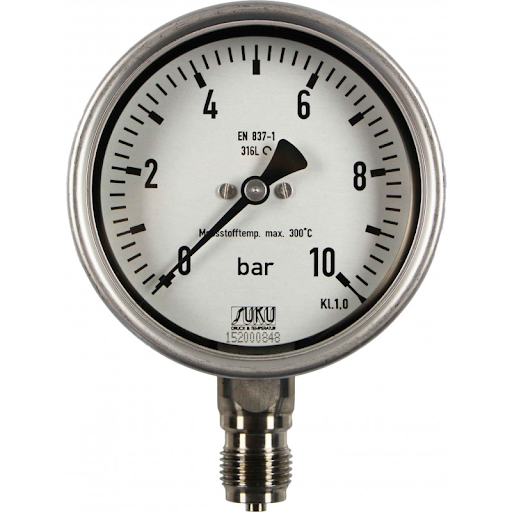
Fig 6. A bourdon tube
These are descriptions and explanations for some of the manometer types. If you'd like to learn about other types or have more specific questions about any of them, please let me know.
Comparing table
Certainly, here's a comparison table summarizing the key features and characteristics of the different types of manometers:
| Type of Manometer | Description | Working Principle | Applications | Pressure Range | Industries | Pros | Cons |
| U-Tube Manometer | U-shaped tube partially filled with liquid | Hydrostatic pressure | HVAC, laboratories, industrial processes | Wide (depends on the liquid used) | Various | Simple design, cost-effective | Limited precision, affected by temperature |
| Inclined Manometer | U-tube inclined at an angle for higher precision | Hydrostatic pressure | Laboratories, research | Moderate | Research, fluid dynamics | Improved precision for small differences | Moderate pressure range may be complex to read |
| Piezometer Tube | Vertical tube measuring point pressure | Hydrostatic pressure | Geotechnical engineering, hydrology | Low to moderate | Civil engineering, environmental monitoring | Direct point pressure measurement | Limited to specific point measurements |
| Bourdon Tube | Curved tube deforms with pressure | Mechanical deformation | Industrial processes, automotive | Wide | Automotive, manufacturing, oil and gas | Suitable for broad pressure range, robust | Less accuracy compared to lab-grade instruments |
| Digital Manometer | Electronic sensors with digital display | Electronic pressure sensors | Various (industrial settings) | Wide range, model-dependent | Industrial processes, HVAC | Precision, ease of use, digital readout | Requires power source, costlier than basic manometers |
| Differential Manometer | Two U-tube manometers for pressure differences | Hydrostatic pressure | HVAC, fluid systems, filters | Wide (depends on liquid used) | HVAC, fluid systems | Measures pressure differences | Complex setup, limited to pressure differences |
| McLeod Gauge | Measures very low pressures | Compresses gas and measures pressure increase | Vacuum systems, high-vacuum applications | Extremely low | Scientific research, vacuum technology | Precision for low pressures | Limited to very low-pressure applications |
| Manometric Capsule | Two flexible capsules connected | Capsule deformation | Limited applications requiring capsule measurements | Low to moderate | Specialized applications | Direct capsule deformation measurement | Limited to specific applications |
| Ultrasonic Manometer | Uses sound waves for pressure measurement | Ultrasonic waves | Non-intrusive measurement, various applications | Model-dependent | Various | Non-contact measurement | Model-dependent accuracy |
| Pitot Tube Manometer | Measures fluid velocity using dynamic and static pressure | Bernoulli's principle | Aerodynamics, fluid dynamics | Low to moderate | Aerospace, fluid mechanics | Measures fluid velocity, not static pressure | Requires knowledge of fluid dynamics |
Please note that the pressure range and other characteristics can vary depending on the specific model and design within each type of manometer. Additionally, the choice of manometer should be based on the specific requirements of your application.
Manometer applications
Manometers have a wide range of applications across various industries due to their ability to measure pressure differences in gases and liquids accurately. Here are some common applications of manometers:
- HVAC (Heating, Ventilation, and Air Conditioning): Manometers are used to measure air and gas pressures in HVAC systems, ensuring proper ventilation and temperature control.
- Chemical Engineering: They are used to monitor and control pressure in chemical processes, including distillation, filtration, and reaction vessels.
- Fluid Dynamics Research: Manometers play a vital role in fluid dynamics experiments and research, helping scientists and engineers study the behavior of fluids in various conditions.
- Environmental Monitoring: Manometers are used in environmental monitoring equipment to measure air and water pressures, particularly in applications like weather stations and air quality monitoring.
- Hydrology: In hydrology and groundwater studies, manometers are used to measure water table levels and pressure in wells and boreholes.
- Aviation and Aerospace: Manometers are used in aircraft instruments to measure airspeed, altitude, and cabin pressure, ensuring the safety and comfort of passengers and crew.
- Automotive Industry: Manometers are used in automotive diagnostic tools to measure engine vacuum and test various components, such as the exhaust system.
- Medical Equipment: In medical devices like ventilators and anesthesia machines, manometers are used to monitor and control gas pressures during patient care.
- Fluid Transport and Distribution: In pipelines and fluid transport systems, manometers help ensure the proper flow and pressure of liquids and gases.
- Research and Development: Manometers are essential in laboratory settings for various research applications, including material testing, fluid mechanics, and pressure-sensitive experiments.
- Industrial Processes: Many industrial processes require precise pressure control and monitoring. Manometers are used to ensure safety and quality in these processes.
- Vacuum Technology: In vacuum systems, specialized manometers like McLeod gauges are used to measure extremely low pressures, crucial in semiconductor manufacturing and research.
- Petroleum and Petrochemical Industry: Manometers are used to monitor and control pressures in oil and gas drilling, refining, and transportation processes.
- Biotechnology: In biotech labs, manometers are used in various applications, including cell culture, fermentation, and bioprocessing.
- Meteorology: Manometers are used in meteorological instruments and weather stations to measure atmospheric pressure, which is essential for weather forecasting.
- Geotechnical Engineering: In geotechnical studies, manometers are used to measure pore water pressure in soils and rock formations to assess stability and groundwater flow.
- Food and Beverage Industry: Manometers play a role in ensuring the proper pressure for carbonation in beverages, pasteurization processes, and other food production applications.
- Pharmaceutical Industry: Manometers are used in pharmaceutical manufacturing to control pressure during drug production and packaging.
These are just a few examples of the many applications of manometers across various industries. The specific type of manometer and its characteristics depend on the unique requirements of each application.
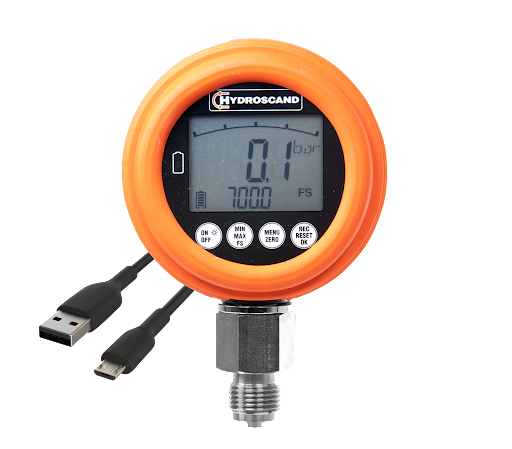
Fig 7. Digital Manometer
Installation and Maintenance
How can use the manometer?
Using a manometer to measure pressure is a relatively straightforward process, but it requires careful setup and attention to detail. Here are the general steps to use a basic U-tube manometer:
Materials and Equipment You'll Need:
- Manometer (U-tube or another type)
- Suitable liquid for the manometer (e.g., mercury, water, oil)
- Tubing and connectors (if needed)
- A source of pressure or a system to measure
- Protective equipment (gloves, goggles, if working with hazardous substances)
Step-by-Step Guide:
- Safety Precautions: If you are working with hazardous materials or high pressures, ensure you have the necessary safety equipment and follow safety protocols.
- Select the Manometer: Choose the appropriate type of manometer for your application and the pressure range you need to measure.
- Fill the Manometer Tube:
- If you are using a U-tube manometer, partially fill it with the selected liquid. Be sure not to overfill; leave some air space at the top.
- If you are using a different type of manometer, follow the manufacturer's instructions for filling and setup.
- Connect the Manometer:
- Connect one end of the manometer (usually a tube or a port) to the system or point where you want to measure pressure.
- Ensure that all connections are airtight to prevent leaks.
- Reference Point: Make sure that the other end of the manometer is open to the atmosphere (or another reference point if necessary). This establishes a reference level for pressure measurements.
- Zeroing the Manometer (if needed): If your manometer has been used before or if you want to measure pressure differences, set the liquid levels in both arms of the U-tube or reference point to the same height. This establishes a zero reference.
- Measure the Pressure:
- Apply the pressure or allow the system to generate pressure. This could involve turning on a pump, opening a valve, or whatever action is appropriate for your setup.
- As the pressure changes, the liquid level in the manometer tube will shift. The difference in liquid levels between the two arms of the U-tube or from the reference point to the measurement point corresponds to the pressure being measured.
- Read the Pressure: Use the scale or markings on the manometer to read the pressure difference in units relevant to your measurement (e.g., psi, mmHg, Pa).
- Record the Measurement: Note the pressure measurement for your records.
- Release Pressure: If necessary, release the pressure in the system to return the manometer to its initial state.
- Clean and Store: After use, clean the manometer thoroughly if it has been in contact with hazardous materials. Store it properly to prevent damage or contamination.
Remember to follow any specific instructions provided with your particular manometer, especially regarding the choice of liquid, calibration, and maintenance. Additionally, if you are working with high-pressure systems or potentially hazardous substances, take all necessary safety precautions and adhere to safety guidelines and regulations.
How can calibrate the manometer?
Calibrating a manometer involves verifying its accuracy by comparing its measurements to a reference standard or a known pressure source. Calibration ensures that the manometer provides reliable and accurate pressure readings. Here are the general steps to calibrate a manometer:
Materials and Equipment You'll Need:
- Manometer to be calibrated
- A reliable reference standard or pressure source with known and traceable accuracy
- Tubing and connectors (if needed)
- Calibration equipment (pressure calibrator, pressure gauge, or similar)
- Calibration certificates for reference standards (if available)
- Record-keeping materials (e.g., calibration log)
Step-by-Step Guide:
- Safety Precautions: Ensure that you follow safety protocols, especially if you are working with high-pressure systems or hazardous substances.
- Select the Calibration Equipment: Choose an appropriate reference standard or pressure source with a known and traceable accuracy. This could be a certified pressure gauge, pressure calibrator, or another calibrated instrument.
- Prepare the Manometer: Make sure the manometer is clean and in good working condition. Ensure that the liquid is at the correct level and that the manometer is properly connected to the reference point and the system you want to measure.
- Zero the Manometer (if needed): If your manometer requires zeroing or adjustment, set the liquid levels in both arms of the U-tube or the reference point to the same height, as explained in the manometer's user manual.
- Connect the Calibration Equipment:
- Connect the calibration equipment to the manometer. Ensure that all connections are airtight to prevent leaks.
- If you're using a pressure calibrator, it should have a known and traceable accuracy. If using a pressure gauge, make sure it's recently calibrated and has a valid calibration certificate.
- Stabilize the System: Allow the system and the manometer to stabilize at the desired pressure level. This may involve pressurizing or depressurizing the system gradually to minimize dynamic effects.
- Record the Pressure: Record the pressure reading displayed by the manometer being calibrated and the reference standard or pressure source. Ensure that the measurements are taken simultaneously or under the same conditions.
- Repeat Measurements: Perform several measurements at different pressure levels, if possible, covering the range you expect to use the manometer for.
- Calculate Calibration Error: Calculate the calibration error for each measurement point by comparing the manometer's readings to the readings from the reference standard or pressure source. The calibration error is the difference between the two measurements.
- Adjust or Document Errors: Depending on the calibration results, you may need to adjust the manometer to correct for any systematic errors (e.g., zero offset). Alternatively, you can document the calibration errors for future reference.
- Create a Calibration Certificate: Record all calibration measurements and results in a calibration certificate or log. Include the date of calibration, the equipment used, the measured values, and any corrections applied.
- Maintain Calibration Records: Keep detailed records of the manometer's calibration history. This documentation is essential for traceability and ensuring ongoing accuracy.
- Perform Periodic Recalibration: Regularly recalibrate the manometer at scheduled intervals or whenever there is a reason to suspect a loss of accuracy (e.g., after a mechanical shock or if it's been in service for an extended period).
- Label Calibration Status: If applicable, label the manometer with the calibration date and next calibration due date to indicate its current calibration status.
Calibrating a manometer should be performed by trained personnel or a certified calibration service provider if high accuracy is required, or if the manometer is used in critical applications where accuracy is paramount. Calibration practices may vary depending on the type and model of the manometer, so it's essential to consult the manufacturer's guidelines and recommendations for specific calibration procedures.
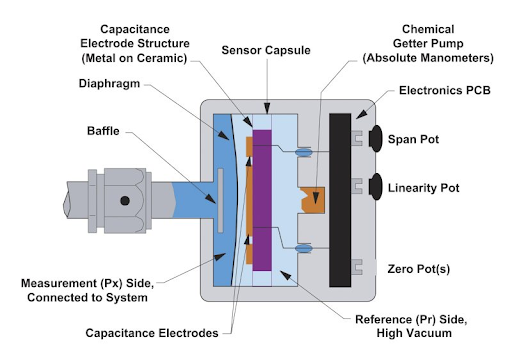
Fig 8. Capacitance manometer schematic
How can measure the manometer accuracy?
Measuring the accuracy of a manometer involves comparing its readings to a known and traceable reference standard or pressure source. Here's a step-by-step guide on how to measure the accuracy of a manometer:
- Materials and Equipment You'll Need:
- Manometer to be tested (the device whose accuracy you want to measure)
- A reliable reference standard or pressure source with a known and traceable accuracy
- Tubing and connectors (if needed)
- Calibration equipment (pressure calibrator, pressure gauge, or similar)
- Calibration certificates for reference standards (if available)
- Record-keeping materials (e.g., calibration log)
- Step-by-Step Guide:
- Safety Precautions: Ensure that you follow safety protocols, especially if you are working with high-pressure systems or hazardous substances.
- Select the Calibration Equipment: Choose an appropriate reference standard or pressure source with a known and traceable accuracy. This could be a certified pressure gauge, pressure calibrator, or another calibrated instrument.
- Prepare the Manometer: Make sure the manometer is clean and in good working condition. Ensure that the liquid is at the correct level and that the manometer is properly connected to the reference point and the system you want to measure.
- Zero the Manometer (if needed): If your manometer requires zeroing or adjustment, set the liquid levels in both arms of the U-tube or the reference point to the same height, as explained in the manometer's user manual.
- Connect the Calibration Equipment:
- Connect the calibration equipment to the manometer. Ensure that all connections are airtight to prevent leaks.
- If you're using a pressure calibrator, it should have a known and traceable accuracy. If using a pressure gauge, make sure it's recently calibrated and has a valid calibration certificate.
- Stabilize the System: Allow the system and the manometer to stabilize at the desired pressure level. This may involve pressurizing or depressurizing the system gradually to minimize dynamic effects.
- Record the Pressure: Record the pressure reading displayed by the manometer being tested and the reference standard or pressure source. Ensure that the measurements are taken simultaneously or under the same conditions.
- Repeat Measurements: Perform several measurements at different pressure levels, if possible, covering the range you expect to use the manometer for.
- Calculate Measurement Errors: Calculate the measurement errors for each measurement point by comparing the manometer's readings to the readings from the reference standard or pressure source. The measurement error is the difference between the two measurements.
- Determine Accuracy: Calculate the accuracy of the manometer as a percentage of the measurement error relative to the reference standard. The formula for accuracy is usually expressed as:Accuracy (%) = [(Measured Value - True Value) / True Value] * 100Where:
- Measured Value is the reading from the manometer.
- True Value is the reading from the reference standard or pressure source.
- Evaluate Results: Compare the calculated accuracy with the manufacturer's specified accuracy for the manometer. This will indicate whether the manometer is within its specified accuracy limits.
- Document the Accuracy: Record all measurement results, including the calculated accuracy, in a calibration certificate or log.
- Maintain Calibration Records: Keep detailed records of the manometer's calibration history. This documentation is essential for traceability and ensuring ongoing accuracy.
- Perform Periodic Accuracy Checks: Regularly check the accuracy of the manometer at scheduled intervals or whenever there is a reason to suspect a loss of accuracy (e.g., after a mechanical shock or if it's been in service for an extended period).
- Label Calibration Status: If applicable, label the manometer with the calibration date and next accuracy check due date to indicate its current calibration status.
Measuring the accuracy of a manometer is essential for ensuring that it provides reliable and precise pressure measurements. The accuracy of a manometer can vary depending on factors such as its design, quality, and usage conditions. Regular accuracy checks and calibrations help maintain its performance within acceptable limits.
Manometer Advantages
Manometers offer several advantages, making them valuable tools for measuring pressure in a wide range of applications. Here are some of the key advantages of using manometers:
- Simple and Robust Design: Manometers have a straightforward design, often consisting of a U-shaped tube partially filled with liquid. This simplicity makes them easy to manufacture, operate, and maintain. Their mechanical design is robust and can withstand various environmental conditions.
- Direct Pressure Measurement: Manometers provide a direct measurement of pressure, especially in U-tube configurations. The liquid column in the tube directly reflects the pressure being applied, offering an intuitive and immediate reading.
- Wide Pressure Range: Depending on the choice of liquid and design, manometers can measure a wide range of pressures, from very low pressures (using a sensitive liquid) to high pressures (using a denser liquid).
- Reliable and Accurate: When properly calibrated and maintained, manometers can provide accurate pressure measurements. They are suitable for both precision laboratory measurements and practical industrial applications.
- Inexpensive: Many manometers are cost-effective compared to some electronic pressure measurement devices. This affordability makes them accessible for various industries and applications.
- Compatibility with Various Fluids: Manometers can be filled with different types of liquids, allowing them to be used with a wide range of fluids, including gases and liquids. This versatility makes them adaptable to various environments and substances.
- No External Power Required: Most manometers do not require external power sources, as they rely on a simple mechanical principle (hydrostatic pressure). This independence from power sources can be advantageous in remote or field applications.
- Ease of Installation: Manometers are relatively easy to install and set up. They do not require complex calibration procedures, and their basic principles are straightforward to understand.
- Real-Time Readings: Manometers provide real-time readings, allowing operators to monitor pressure changes immediately. This is crucial in situations where rapid pressure fluctuations need to be observed.
- Durability: Due to their mechanical construction and lack of electronic components, manometers are often more durable and less susceptible to damage from harsh environments, vibrations, or electrical interference.
- Safety: In some applications, manometers are preferred over electronic pressure sensors because they do not produce sparks or electrical discharge, reducing the risk of ignition in hazardous environments.
- Educational Tool: Manometers are commonly used as educational tools in physics, engineering, and fluid mechanics laboratories to help students understand the principles of pressure measurement and fluid behavior.
Despite these advantages, manometers also have limitations, such as limited precision in some cases and the potential for inaccuracies due to temperature fluctuations. Therefore, the choice of pressure measurement instrument should consider the specific requirements of the application and the desired level of accuracy.
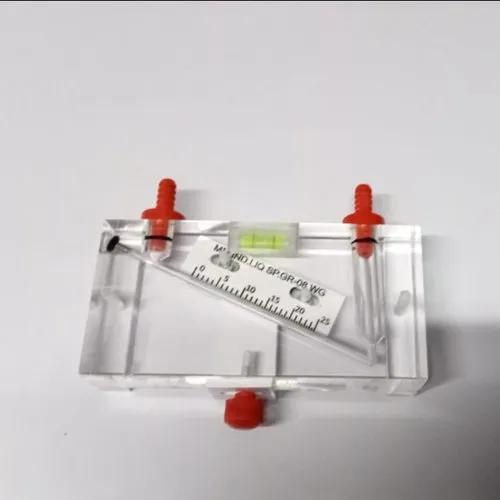
Fig 9. Acrylic Body Manometer
Manometer Disadvantages
While manometers have several advantages, they also come with some disadvantages and limitations, which can affect their suitability for certain applications. Here are some of the disadvantages of using manometers:
- Limited Precision: Manometers may not provide the same level of precision as electronic pressure sensors or transducers. The accuracy of a manometer can be affected by factors such as the meniscus shape, parallax errors in reading the liquid level, and variations in liquid density with temperature.
- Subject to Temperature Changes: Changes in temperature can cause thermal expansion or contraction of the liquid in the manometer tube, leading to measurement errors. Some manometers require compensation for temperature effects.
- Fragility: Glass U-tube manometers are relatively fragile and can break if subjected to mechanical shock or vibration. This fragility can be a drawback in certain industrial environments.
- Limited Portability: Manometers can be bulky, especially in high-pressure applications. Carrying them to different locations for field measurements may not be as convenient as portable electronic pressure sensors.
- Fluid Compatibility: The choice of liquid used in the manometer may limit its compatibility with certain chemicals or substances. In some cases, the liquid can react with the fluid being measured.
- Maintenance Requirements: Manometers require periodic maintenance, including cleaning, checking for leaks, and possible refilling with the liquid. Failure to maintain them properly can lead to measurement inaccuracies.
- Reading Errors: Reading the liquid level in a U-tube manometer can introduce errors due to parallax or distortion in the meniscus. Digital pressure sensors do not have this issue.
- Limited Remote Monitoring: Manometers typically provide local pressure readings and are not well-suited for remote monitoring or integration into automated systems without additional equipment.
- Inability to Measure Dynamic Pressures: Manometers are not ideal for measuring rapidly changing or dynamic pressures, as they may not respond quickly enough to capture fluctuations accurately.
- Health and Environmental Concerns: Some manometer fluids, such as mercury, can be hazardous to health and the environment. The use of mercury has been restricted or banned in many countries due to its toxicity.
- Pressure Limits: Manometers may have pressure limits, both on the high and low ends, depending on the choice of liquid and the manometer's design. Exceeding these limits can damage the instrument.
- Interference with Fluid Flow: In some applications, the presence of a manometer in a fluid system can cause flow disturbances and affect the accuracy of pressure measurements.
Given these disadvantages, it's essential to carefully consider the specific requirements of your application and the level of precision and convenience needed when choosing a pressure measurement device. While manometers are suitable for many applications, more advanced electronic pressure sensors or transducers may be preferable in situations where higher precision, remote monitoring, or rapid pressure response is critical.
Important Factors to Choose the Right Manometer
Choosing the right manometer for a particular application involves considering various factors to ensure it meets your measurement needs accurately and effectively. Here are important factors to consider when selecting a manometer:
- Type of Pressure Measurement:
- Determine whether you need to measure gauge pressure (pressure relative to atmospheric pressure), absolute pressure (pressure relative to a perfect vacuum), or differential pressure (the difference in pressure between two points). Different types of manometers are suitable for different pressure measurements.
- Pressure Range:
- Determine the expected pressure range of the application. Manometers have different pressure ranges, so select one that can cover the range you require.
- Fluid Compatibility:
- Consider the compatibility of the manometer with the fluid or gas you will be measuring. Certain manometer fluids may not be suitable for corrosive or reactive substances.
- Accuracy and Precision:
- Determine the required level of accuracy and precision for your measurements. Some applications demand high accuracy, while others can tolerate lower precision.
- Temperature Range:
- Check if the manometer can operate within the temperature range of your application. Temperature variations can affect the accuracy of some manometers.
- Environmental Conditions:
- Consider the environmental conditions in which the manometer will be used. Some manometers may not be suitable for extreme temperatures, humidity, or exposure to chemicals.
- Fluid Density:
- The choice of manometer fluid should consider the density of the fluid being measured to ensure the manometer provides accurate readings.
- Fluid Level Measurement:
- Determine if the manometer's design allows for easy and accurate measurement of the fluid level, as this can affect measurement accuracy.
- Response Time:
- Assess whether the manometer's response time (how quickly it can react to pressure changes) is suitable for your application, especially if you need to measure dynamic pressures.
- Portability:
- Consider the ease of transporting and installing the manometer, especially if you need to use it in different locations.
- Safety Requirements:
- Ensure that the manometer meets safety standards and regulations, especially when working with hazardous materials or in potentially dangerous environments.
- Cost:
- Evaluate the budget available for the manometer. Different types of manometers vary in cost, so choose one that fits your budget while meeting your measurement needs.
- Ease of Use:
- Consider the ease of setup, calibration, and reading the manometer. Some applications may require a more user-friendly design.
- Maintenance Requirements:
- Assess the maintenance needs of the manometer. Determine if it requires periodic calibration or maintenance and if such services are readily available.
- Industry Standards:
- Check if there are specific industry standards or regulations that dictate the use of certain types or models of manometers in your application.
- Manufacturer and Brand Reputation:
- Choose a reputable manufacturer or brand known for producing reliable and accurate manometers. Read reviews and seek recommendations from industry peers if necessary.
- Future Expansion:
- Consider whether your measurement needs may change in the future. Choosing a versatile manometer can be beneficial if you anticipate expanding your application.
By carefully evaluating these factors and matching them to your specific application requirements, you can select the right manometer that provides accurate and reliable pressure measurements. It's often a good practice to consult with experts in the field or the manometer manufacturer to ensure you make an informed choice.
Five Top Brands of Manometers
Several well-known brands manufacture high-quality manometers for various applications. Here are five top brands known for producing reliable and accurate manometers:
- Fluke Corporation:
- Fluke is a leading manufacturer of electronic test and measurement equipment, including digital manometers. Their products are known for their precision and durability, making them popular choices in industrial and HVAC applications.
- UEi Test Instruments:
- UEi Test Instruments is a reputable brand specializing in HVAC and electrical testing tools. They offer a range of digital manometers designed for HVAC technicians and professionals.
- Dwyer Instruments, Inc.:
- Dwyer is a well-established company known for producing a wide variety of pressure instruments, including manometers. They offer both digital and analog manometers suitable for various industries and applications.
- Kane International Ltd:
- Kane International is a UK-based manufacturer of testing equipment, including combustion analyzers and pressure instruments. They are known for their high-quality digital manometers used in HVAC and industrial settings.
- Ashcroft Inc.:
- Ashcroft is a global manufacturer of pressure and temperature instruments, including manometers. They offer a range of analog and digital manometers known for their accuracy and reliability in critical applications.
These brands have earned reputations for producing manometers that meet industry standards and deliver consistent and precise pressure measurements. When choosing a manometer, consider the specific features, models, and compatibility with your application requirements from these reputable manufacturers.
Conclusion
In conclusion, manometers are versatile instruments used for measuring pressure in a wide range of applications across various industries. They offer several advantages, including a simple and robust design, direct pressure measurement, wide pressure range, and compatibility with different fluids. Manometers are reliable, accurate, and cost-effective tools for pressure measurement.
However, they also have some limitations, such as limited precision, sensitivity to temperature changes, and potential fragility in certain applications. The choice of manometer should be based on careful consideration of factors such as pressure type, range, fluid compatibility, accuracy, environmental conditions, and budget.
Calibrating and periodically checking the accuracy of manometers is essential to ensure their reliability and maintain measurement precision. Regular maintenance and adherence to safety protocols are crucial when working with manometers, especially in industrial or hazardous environments.
Top brands like Fluke, UEi Test Instruments, Dwyer Instruments, Kane International, and Ashcroft are known for producing high-quality manometers that meet industry standards and offer dependable pressure measurement solutions.
Ultimately, choosing the right manometer requires a thorough understanding of your specific application needs and careful evaluation of the factors discussed in this guide. By selecting the appropriate manometer and maintaining it properly, you can ensure accurate and reliable pressure measurements in your operations.
To recap
1. What is a manometer?
- A manometer is a device used to measure pressure, typically in gases or liquids. It consists of a tube partially filled with a liquid, and pressure is determined by the difference in liquid levels in the tube.
2. What are the common types of manometers?
- Common types of manometers include U-tube manometers, inclined manometers, Bourdon tube manometers, digital manometers, and differential manometers, among others.
3. How does a U-tube manometer work?
- U-tube manometers work based on the principle of hydrostatic pressure. The difference in liquid levels in the two arms of the U-tube indicates the pressure difference being measured.
4. What are the advantages of using a manometer?
- Advantages of using a manometer include its simplicity, direct pressure measurement, wide pressure range, reliability, cost-effectiveness, and compatibility with various fluids.
5. What are the disadvantages of using a manometer?
- Disadvantages of manometers include limited precision, sensitivity to temperature changes, fragility in some cases, and potential difficulties with fluid compatibility.
6. How do I calibrate a manometer?
- Calibrating a manometer involves comparing its readings to a reference standard or pressure source with known accuracy. The goal is to ensure that the manometer provides accurate measurements.
7. What factors should I consider when choosing the right manometer for my application?
- Factors to consider include pressure type, pressure range, fluid compatibility, accuracy, temperature range, environmental conditions, ease of use, and budget.
8. What industries commonly use manometers?
- Manometers are used in a wide range of industries, including HVAC, chemical engineering, fluid dynamics research, aerospace, automotive, medical, and environmental monitoring, among others.
9. What are some safety precautions when working with manometers?
- Safety precautions include wearing appropriate protective gear, following safety guidelines for hazardous materials, and ensuring proper setup and maintenance to prevent accidents.
10. Why is it important to periodically check the accuracy of a manometer?
Periodic accuracy checks are essential to ensure that a manometer continues to provide reliable measurements. Over time, factors like wear and temperature changes can affect accuracy, and calibration helps maintain precision.
References
https://qtxasset.com/files/sensorsmag/nodes/2001/1073/fig3.gif
https://www.engineeringclicks.com/manometer/
https://www.mks.com/n/capacitance-manometers
https://www.indiamart.com/proddetail/acrylic-body-manometer-24661218930.html
Recent Posts
-
Booster Pump Troubleshooting and Maintenance: How to Fix and Prevent Common Issues
1. Introduction Imagine turning on your faucet only to be greeted with a weak trickle of water when …22nd Apr 2025 -
Energy-Efficient Booster Pumps: Selection and Tips for Maximizing Performance
1. Introduction Imagine never having to deal with fluctuating water pressure, noisy pumps, or skyroc …19th Apr 2025 -
Booster Pumps for Sustainable Water Systems: Irrigation and Rainwater Harvesting Solutions
1. Introduction Water scarcity is no longer a distant threat—it’s a reality affecti …16th Apr 2025

